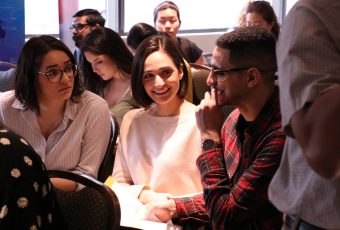Overview
Important: The information on this page is intended to provide you with the basics of the credentialing process. It is your responsibility to contact your provincial regulatory body to ensure you are familiar with the process to return. While we review this content on an annual basis, it is subject to change at any time. Please ensure you review all information provided by the regulatory bodies for the most up-to-date information. OzTREKK is not responsible for your credentialing process.
The Doctor of Optometry degree granted by the University of Melbourne is the only graduate optometry program offered in Australia. Graduates of this program aiming to practice optometry in Canada are required to complete an International Optometric Bridging Program (IOBP) such as the new Advanced Standing Optometry Preparatory Program offered by the University of Waterloo in Ontario.
According to the Canadian Association of Optometrists website, international graduates are those who have obtained their optometric education from a school other than those accredited by the Accreditation Council on Optometric Education, the only accrediting body for professional optometric degree programs, optometric residency programs and optometric technician programs in the United States and Canada.
Steps to Practice in Canada
How do you become an optometrist in Canada?
Step #1 Graduate with a Doctor of Optometry degree or equivalent
Step #2 Have credentials assessed by the Federation of Optometric Authorities of Canada (FORAC)
The FORAC credential assessment is what determines if an applicant can take the IGOEE (Step 3). Please note, FORAC requires a 4-year optometry program, and also 3 years of either undergraduate university science studies or full-time work experience as a licensed optometrist before applicants are permitted to apply to FORAC.
Step #3 Take the Internationally Graduated Optometrist Evaluating Examination (IGOEE)
Those approved will write the IGOEE, which will determine whether an applicant is able to proceed directly to the OEBC Exam & OSCE (Step 5) or whether a bridging program is required first.
You should anticipate having to take the ASOPP program as part of the certification process as it may be required.
Step#4. Advanced Standing Optometry Preparatory Program (ASOPP)
The University of Waterloo School of Optometry and Vision Science (WOVS) offers a new educational pathway each year for up to 6 qualified internationally trained optometric graduates (IOGs), the Advanced Standing Optometry Preparatory Program (ASOPP).
Eligible IOGs will be required to
- apply to ASOPP through the Ontario University Application Centre (OUAC) for a $215 application fee; and
- complete a Computer-Based Assessment for Sampling Personal Characteristics (Casper).
WOVS will offer one ASOPP program, during the Spring academic term (April–August). Students who successfully complete all ASOPP components will be admitted as Advanced Standing students in the fall term of the third year of the Doctor of Optometry program. Successful completion of the OD program (years 3 and 4) will lead to the granting of a Doctor of Optometry degree from the University of Waterloo. Graduates will be eligible to sit for the national board examination for licensure/registration in Canada.
| Spring term (April – August) | Fall term (August – December) | Winter term (January – April) |
| ASOPP | Year 3 term 1 | Year 3 term 2 |
| Year 4 term 1 | Year 4 term 2 | Year 4 term 3 |
- Length: Orientation term, followed by 1.5 years (3rd and 4th years) of OD program.
- Number of spaces for 2025: 6; demand far exceeds this
Admission for the ASOPP is based on IGOEE scores (above, Step 3) that are placed in rank order. Meeting the minimum eligibility threshold on the IGOEE does not guarantee an offer of admission to the ASOPP.
It is important to understand that the demand for the ASOPP typically exceeds the program capacity.
Step #5 Pass the national exam
Administered by the Optometry Examining Board of Canada (OEBC), which consists of Written Exam and OSCE.
Step #6 Register with your provincial optometric regulatory authority
More of a visual person? see the flowchart that describes the process.
Details by Province
- College of Optometrists of British Columbia
- Alberta College of Optometrists
- Saskatchewan Association of Optometrists
- Manitoba Association of Optometrists
- College of Optometrists of Ontario
- Ordres des Optometristes du Quebec
- New Brunswick Association of Optometrists
- Nova Scotia College of Optometrists
- Prince Edward Island College of Optometrists
- Newfoundland and Labrador College of Optometrists
Practicing in Australia
Australian Accreditation
The Optometry Council of Australia and New Zealand (OCANZ) is the accreditation authority responsible for performing accreditation functions for the optometry profession. These functions include assessment of programs of study in Australia and assessment of overseas qualified optometrists seeking registration in Australia. The University of Melbourne’s Doctor of Optometry is Accredited by OCANZ (approved until 2023).
Graduates of accredited Australian programs must register with the Optometry Board of Australia before practicing in the country. You can check out the OBA’s registration page for more information on the process.
Graduates of Melbourne’s Doctor of Optometry program are eligible to apply for Australian Registration (OCANZ). If successful, you will then be able to apply for general skilled migration to Australia.
Australia’s skilled visa programs are designed to target genuine skill shortages in Australia, one of those being optometrists. This means that there are specific visas available to individuals who are qualified to work or train as an optometrist in Australia and can meet all other requirements. You are strongly advised to contact the Australian Department of Home Affairs either here in Canada or while you are in Australia for full details.
FAQs
Can my partner or family come to Australia with me if I get an offer?
Many Canadians wish to fulfill their career goals after getting married, having kids, or both! We’ve had plenty of students who have taken their partner and/or children with them.
If you want to take your partner or family with you, you’ll need to add them as a secondary applicant or dependents to your student visa application. Even if you don’t plan on taking them with you, we suggest you add them to your application anyway because it can be complex, expensive, and time-consuming to add them afterwards. You’ll then need to provide additional documentation to support your claims of a relationship or your children’s dependency status.
In addition to looking after the visa, you’ll also need to ensure they’re included on your Overseas Student Health Cover (OSHC), you have appropriate accommodation, and if you’re bringing children, you’ll need to enroll them in school.
Visit our Health Insurance page for more information.
When should I apply?
We recommend you begin your OzTREKK application about a year before your program would start. Most programs in Australia start between January and March, so that means you would start your OzTREKK application between January and March the year prior.
Here’s how the typical “cycle” works if your program starts January – March:
March – May: You gather all required documents like passport photo page, transcripts, résumé, personal statement, and send them to our office. Don’t worry, we’ll tell you exactly what we need!
June – August: Interviews (if your program requires one)
September – December: Offer time! If you get an offer, we’ll walk you through the acceptance (or decline) process and give you all the help you need to get ready to go.
January – March: Time to head Down Under!
Can my entire application be submitted through OzTREKK?
Absolutely. We manage and submit your application(s) on your behalf and communicate any updates from the universities.
Applying to an Australian or New Zealand university starts by filling out our OzTREKK application: You’ll tell us a bit about yourself, like your name, address, date of birth, education history, and what schools you want to apply to!
When you click “Submit,” the application with all your information only comes to us, so there’s no need to worry about making a mistake at this stage. We then create a file for you (based on your name, not a number!) and email you a list of documents required to complete your application—things like passport photo page, transcripts, résumé, personal statement—but it depends on the program, as some programs require more paperwork than others.
If you get an offer, we’ll help you with that part, too! Whether you want to accept or decline, we’ll help you figure out your next steps. If you accept your offer, we’ll even help you get ready to go. We’re here to be an advocate for you, and to walk you through the entire process from start to finish.
Should you have any questions along the way, just send us an email or book a chat. That’s why we’re here!
Are there any scholarships for international students?
Scholarship options in Australia are usually limited for international students as they tend to be reserved for those undertaking postgraduate research degrees; however, we can advise you where to look and whether specific programs have a history of offering scholarships.
Occasionally, scholarships are granted to high achievers—those with very high marks. In previous years, we have seen $5000- to $10,000-scholarships given to OzTREKK students.
Check out OzTREKK’s Financing page to learn more about scholarships and paying for your degree.
Do you have course outlines on file?
Before sending us outlines, check to see if we’ve already got them. We can save you a lot of time and ensure we’re submitting good outlines on your behalf. Outlines must be within 2 years of the time you took the course (as listed on your transcript).
I received a low mark on my prerequisite course. Will this impact my application?
To meet the prerequisite subjects, you need to have been granted the credit (passed); the grade isn’t considered in the prerequisite assessment.
What does “rolling admissions” mean?
Rolling admissions means the university assesses applications as they are received, or on a “first come, first served” basis. As soon as they’ve met the quota and the program is filled, they close the applications. So, for a program that has rolling admissions, the earlier you apply the better!
How does OzTREKK know if my application will be competitive?
The majority of Canadians applying to full-degree programs in Australia (i.e., not study abroad courses, which usually only last a semester or two) apply through OzTREKK. They’re studying medicine, dentistry, law, physiotherapy, occupational therapy, etc.
Since they’re using OzTREKK’s services, this gives us a good idea of the starting point of a competitive application each year, allowing us to help you determine which universities/programs are most likely to present you with a letter of offer!
You can get started on determining your chances by reviewing the admissions requirements on each program page. Then, visit our GPA Conversions and Eligibility pages for details and suggestions to help you get into the program of your dreams. Of course, OzTREKK is always here to help if you have questions.
What is a 5.0 GPA in Australia?
Unlike in Canada, GPAs in Australia are simple. They are standardized, so they mean the same thing to everyone.
In Australia, a 5.0 / 7.0 would roughly translate to a 2.7 / 4.0 or approximately 70% – 72%, but keep in mind all universities assess slightly differently.
Learn more on our GPA Conversions page where we list the most common Canadian GPA scales to their corresponding Australian GPA grade.
Which prerequisites do I need?
Prerequisite courses vary by university and by program. We’ve listed university- and program-specific requirements on each program’s page under “Admissions Requirements.”


































Ask A Question
Ask us about your program of interest, or if you have a question about our services.
CONTACT US TODAY